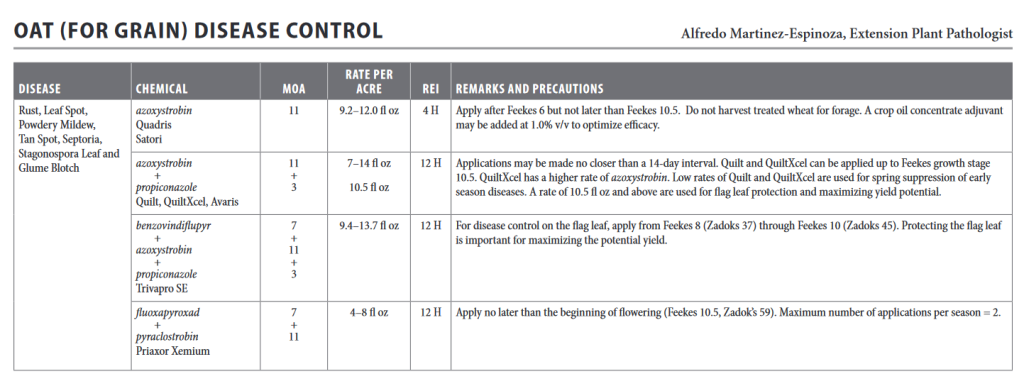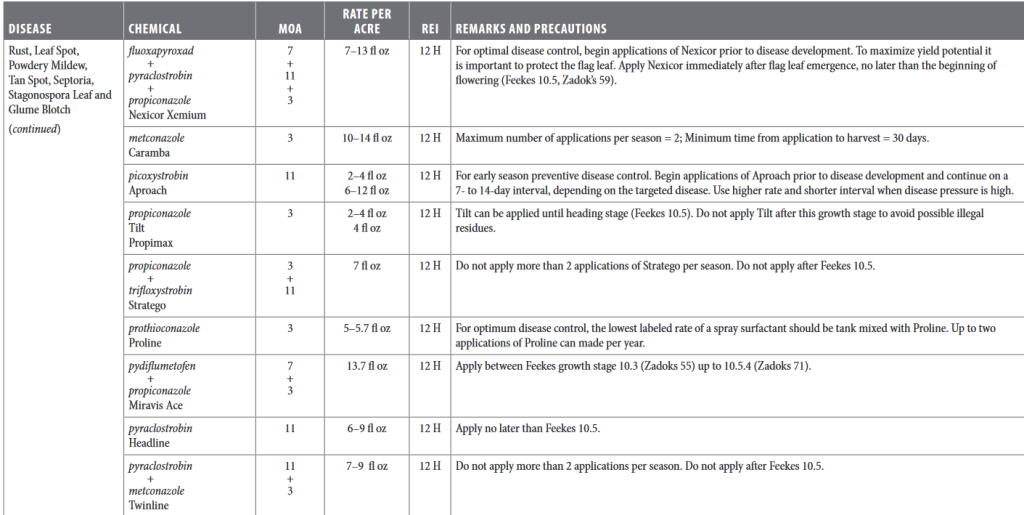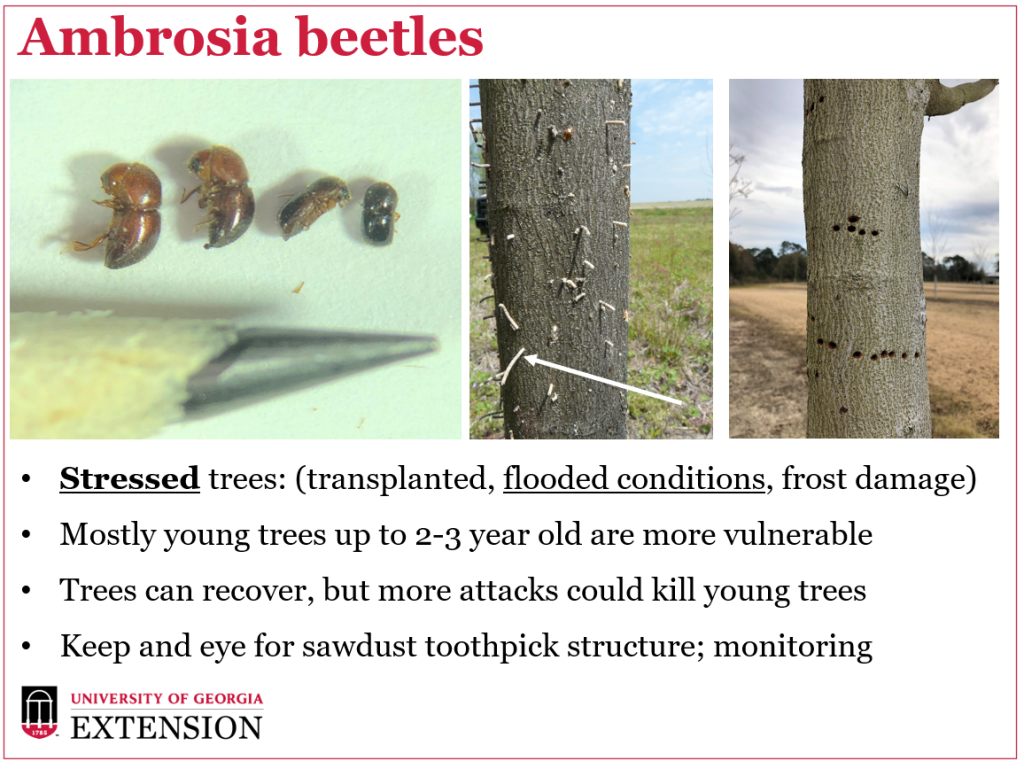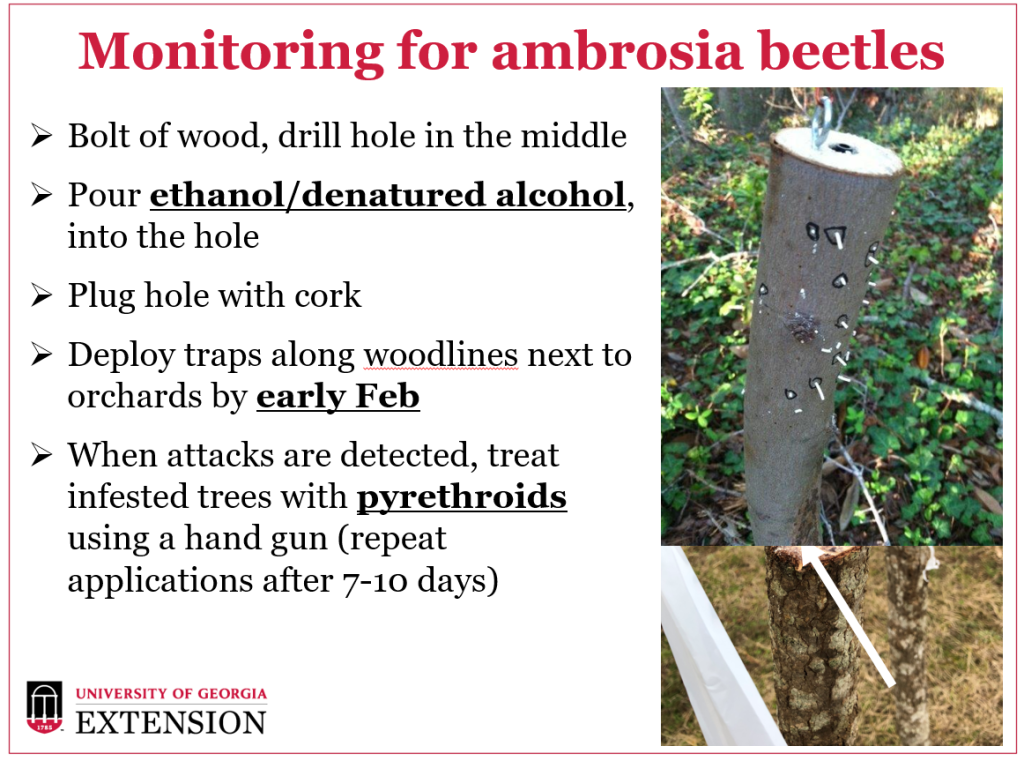In this issue: Colquitt County Cotton Production meeting!!! What are the current soil temperatures? Corn Questions!! Small grain situation… Considerations and Plan for Ambrosia Beetle Management
Colquitt County Cotton Production meeting!!!

What are the current soil temperatures? The weather has been great over the last few days and corn growers are getting excited. The illustration below shows the average soil temperature at the 2 inch depth for February 23, 2023. This information is from UGA Weather Network…

The table below shows the max and min temperatures, wind speed and soil temperatures at three depths from the Sunbelt Ag Expo location of the UGA Weather Network from February 18-24, 2023.

Corn Questions!!
Nitrogen management… Apply 25 to 30 percent of the projected nitrogen needs before or at planting. The remaining nitrogen can be applied sidedress and/or injected through the center pivot systems (fertigation). If all the nitrogen is applied with ground equipment, apply 50 to 75 pounds per acre at or before planting under irrigated conditions and 20 to 50 pounds per acre in dryland environments and the rest when the corn is 12 to 16 inches tall. If nitrogen is to be injected through the irrigation system, apply 40 to 60 pounds at or before planting and begin ground or injected applications of 30 to 60 pounds of nitrogen per acre when the corn is 8 to 12 inches tall. Continue on a bi-weekly basis until the total required nitrogen is applied. Three to five applications of nitrogen will be needed during the growing season. Nitrogen rates are based off 1.2 lbs per bushel yield goal.
When can I start planting corn? At planting soil temperatures at the 2-inch depth should be at or exceed 55o F. Germination progresses slowly at temperatures between 55 and 60o F and emergence will take between 7 – 12 days. Conversely, germination will progress rapidly when corn is planted in soil temperatures greater than 60o F and emergence will be prompt. If your 2-inch soil temperature is 55o F or above but your forecasted weather could drop soil temperatures below this threshold, then planting should be delayed until warmer temperatures return.
Corn planting can begin as early as mid-March in South Georgia but may not begin until mid-May in north Georgia. Early planted corn will traditionally out yield late planted corn regardless of region within the state. Delaying corn planting into the summer can dramatically decrease yield potential. Generally speaking, yields decline at a rate of ¾ bushels per day as you progress later in the planting window and can rise to about 2.5 bushels per day when planting after the optimal window. If corn planting is delayed into the summer, yield losses become much more dramatic. Studies in Tifton indicate that stress and disease tolerant hybrids planted under irrigation in late May to early-June only yield approximately 50% of mid-March to early-April plantings.
What row spacing for corn? Traditional row spacing utilized in Georgia production is 36 inches. Many of the state’s high-yield corn growers have already made the switch to narrower rows such as 30 and 20 inches, and a few have even transitioned to 15-inch row spacing in corn. While row spacings of 30 to 36 inches are adequate to reach top yields, research has indicated that narrower row spacings are associated with greater corn yields (Table 3). Greater yields are achieved in narrow row spacings by allowing plants to exploit more soil area for moisture and nutrients while producing a full canopy to maximize total sunlight capture.


Mr. Kichler, what are herbicide rates that Dr. Proskto recommend for corn burndown?
The following are the burndown rates are form the UGA Pest Management Handbook.
Glyphosate at 0.75 lb ae/A (22 oz/A of 4.5 lb ae/gal or 32 oz/A of 3 lb ae/gal).
Paraquat at 0.75 lb ai/A (3 pt/A of paraquat 2SL or 2 pt/A of paraquat 3SL); glufosinate at 0.40-0.53 lb ai/A (22-29 oz/A of Ignite 2.34SL);
atrazine at 1.0 lb ai/A (1 qt/A of atrazine 4L),
Valor SX 51WG at 2 oz/A;
2,4-D amine at 0.48 lb ai /A (1 pt/A of 2,4-D Amine 3.8SL).
Growers can read about corn production from past blog posts.
Small grain situation… The area wheat crop ranges from full tiller to early stem elongation. Low levels of leaf rust has been noticed in some area wheat fields. According to the publication Identification and Control of Leaf Rust of wheat in Georgia, High relative humidity and/or free moisture and temperatures ranging from 59 °F to 77 °F (15 °C to 25 °C) are conducive for leaf rust to develop. The optimum temperature for urediniospore germination is 68 °F (20 °C). If these conditions exist, infection can occur in 6 to 8 hr. Leaf rust epidemic severity increases exponentially over time. Dry, windy days, which disperse spores followed by cool nights with dew, also favor leaf rust epidemics. Urediniospores serve as primary inoculum by virtue of long distance dispersal by wind.
Fungicides options for wheat are available in the 2022-23 UGA Pest Management Handbook..

Generally, varieties with higher levels of resistance will have smaller pustules than varieties
with lower levels of resistance. Varieties with poor resistance will also have larger yellow halos
around the pustules. Information about wheat disease packages are below.

Oats!! The oat crop in Colquitt County ranges from full tiller to stem elongation. Crown rust has been noticed in area oats this past week. Crown/leaf rust, caused by the fungal pathogen Puccinia coronata f. sp. avenae, is one of the most problematic and damaging diseases of oats in Georgia. For silage or seed oat, there are a number of LEGAL fungicides that may be effective. However……producers must follow labeled instructions for harvest withdrawal periods.



I am getting a few calls about ambrosia beetles in pecans. Lets discuss tips for managing this pest and this information came from the UGA Pecan Blog post 2023 Ambrosia Beetle Update
Considerations and Plan for Ambrosia Beetle Management
The best management approach is this:
- Set ambrosia beetle traps to determine first flight
- Once hits are observed on traps, scout pecan trees
- Spray pecan trees with bifinthrin or permethrin every 7 – 10 days
- Continue monitoring traps adding ethylene into drill holes once a week
The reason we begin with traps is because spraying trees is not as convenient as it sounds. In our original research of control methods, we found ambrosia beetles like to go down into the tree guards. This means you either 1) take off the tree guards to spray with an airblast sprayer or you 2) use a hand wand sprayer to spray trees individually making sure to spray down into the tree guard.
This is not something you want to do before you know when beetles are flying and how much beetle pressure is on the farm. The next question asked is is why do we spray so often?
Spray Interval Research
In our original management research, we compared painting trees with white latex paint with spraying pyrethroids. We chose 7-day interval applications knowing the pyrethroid would not stay on the tree long. Statistically, research showed the best options was either 1) applying pyrethoird insecticide to painted trees or 2) spraying pyrethroid at 7 day intervals.
Knowing seven-day interval spray is a lot for growers to come back and spray individual tree, Dr. Apurba Barman and I are going to test if this interval can be extended to 14 days instead of 7-days. We are also not sure whether we need to use full labeled rate or pyrethroid or lower rate can do the job. Through this particular experiment, we are also going to evaluate how low and high rate of pyrethroid application impact ambrosia beetle control. The primary goal of this experiment is to reduce use of insecticide as well as burden of spraying the young trees so frequently.
Written by: Dr. Apurba Barman & Andrew Sawyer


If you have any questions about corn production please contact your local county agent.
Jeremy M. Kichler
Colquitt County Extension Coordinator
